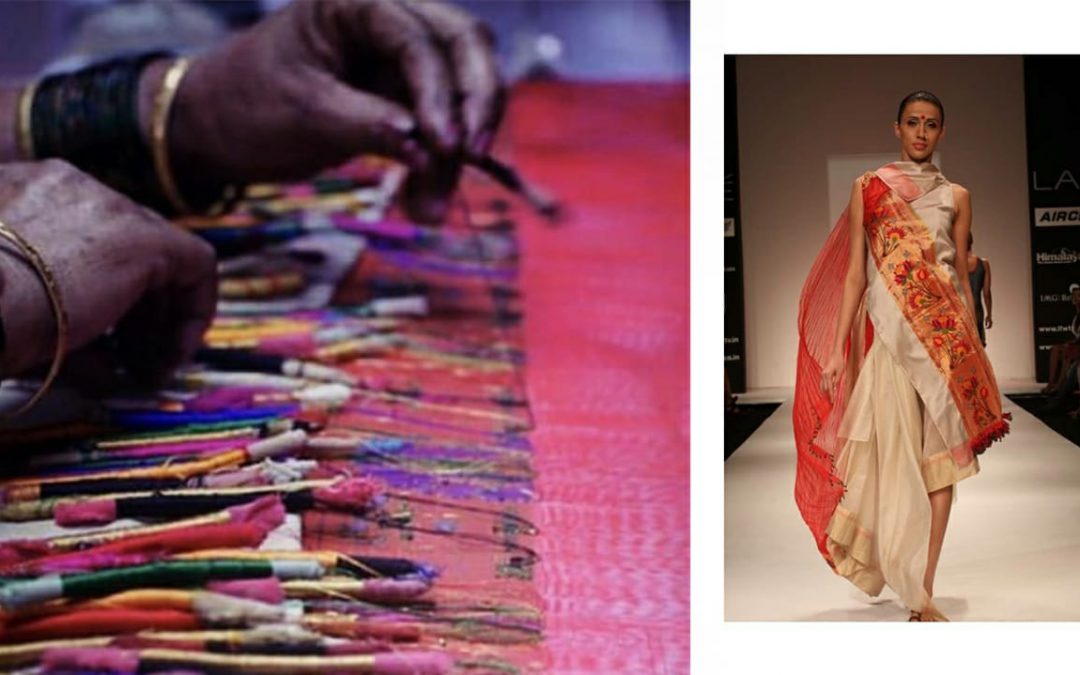India – the home to Chikankari, Gota-Patti and, the womb of Khadi, the place where Banarasi silk and Kanjeevaram took its first breath. India’s rich heritage has contributed to the fashion industry in immense ways. With the modern fashion industry becoming increasingly aware and striving for a sustainable future, it only made sense for India to take a dip into its legacy. Indian history is on its revival journey thanks to a new generation of designers, bringing about a much-needed fashion revolution.
The past few years have seen a rise in conversations about sustainability, green living, waste reduction, and growing appreciation for local artisans. The pandemic, however – with people experiencing a first-hand panic due to lack of resources – amplified these whispers into concrete action. The lockdown led to changes in consumer behaviors and consumption habits. With people opting for comfort over glam and preferring long-lasting pieces instead of fast fashion. The pandemic also brought about a fresh wave of heightened focus on ‘Make in India’, local artists, and self-sustenance.
Our country has always been lush and diverse in techniques, fabrics, tools, and skills passed on from generation to generation. However, something that hasn’t been explored enough was the amalgamation of vibrant Indian designs on sleek contemporary silhouettes. It was when young design virtuosos, combined the exuberant Indian textiles with the minimalistic design aesthetic hand worked on by exceptionally skilled karigars, that the design world was taken by storm.

PC: Shivani Gandhi
Take, for example, our alumna and textile designer Gunjan Jain, who with her design studio ‘Vriksh’ has been working for over a decade now in this field, empowering local artisans of Odisha and revitalizing the traditional craft of the place. Then there is Vaishali Shadangule, our alumna and a devout Indian textile evangelist, who is currently making waves across international platforms by stitching together traditional fabrics like khunn and chanderi with a modern and innovative design approach. Another Pearl Alumna, Shivani Gandhi, is also creating magic with her homegrown brand ‘Ito’, bringing the Japanese art of minimalism together with traditional Indian techniques of weaving and dyeing, to make timeless pieces using only ethical and sustainable practices. And how can we forget Amit Wadha, another of our super talented alumnus, who recently showcased at the Lakme Fashion Week with his brand ‘AW’, which is an ode to his love for Khadi and his designs are a beautiful tale to the glorious Indian past. The list of course goes on and on. The leading industry names have also not been impervious to this movement. Be it a Ritu Kumar, Anju Modi, or Anita Dongre, almost everyone in the industry is merging traditional karigari and handlooms with a contemporary narrative to ride this ripple.

PC: Gunjan Jain
This movement is only gaining momentum and we’re sure a myriad of innovation and creativity is coming our way. The assortment of Indian textiles has been getting larger appreciation from the international markets due to the flexibility, variety, and creativity they provide. On the other hand, Indians are getting more and more attached to the traditional materials, with a need to feel connected with their culture once again. Because that’s the thing with fashion. It’s all about experimenting, expressing, and experiencing. Over the years, fashion has been like the scribe of the ages. It has been modified and reformed and renewed by anyone and everyone who had something unique to say, something distinctive to show. Be it good times or bad, fashion, the outlet of emotions, and self-expression will always get rejuvenated and we will always be diving back to the roots the same way as we will always be endeavoring to create something futuristic.

PC: Vaishali Shadangule
It is keeping in mind this trajectory of the fashion world and specifically of the textile industry that our UG course in Textile Design is crafted. From mapping global trends, experimenting with new tools and techniques, engaging in contextual design studies to an end-to-end understanding of our society and culture, our course imbues our future leaders and textile professionals with a responsible and futuristic vision. A perfect mix of traditional and technical practices, this program helps our students explore the world of textiles through the means of live industry projects – an exclusive opportunity to understand the finer nuances of the demand and supply chain of the ecosystem. On top of this, our expert masterclasses with industry stalwarts, rigorous practical training, and an innovative learning pedagogy arm our students with advanced skills and understanding of traditional textile and crafts, fashion form and function, and design processes required to meet ever-evolving consumer demands.


PC: Amit Wadhwa












